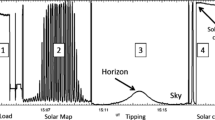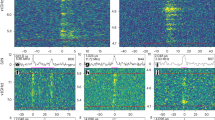Abstract
Stationary type IV solar radio bursts (IVSs) are broadband continuum emission observed at decimetric–decametric wavelength without apparent source motions. They are closely associated with solar flares and/or coronal mass ejections. Earlier studies on IVSs suffered from limited number of events, frequency coverage and available channels, and spatial resolution. Here we present an analysis on 34 IVSs using two-dimensional imaging data provided by Nançay Radioheliograh (NRH) at 10 frequencies from 150 to 445 MHz. The events are recorded from 2010 to 2014. We focus on general properties including the spatial dispersion of sources with frequency, brightness temperature (\(T_{\mathrm{B}}\)) and corresponding spectra, and polarization. Main findings are: (i) In the majority of events (23/34) regular and systematic source dispersion with frequency can be clearly recognized. (ii) In most (31/34) events the maximum brightness temperature (\(T^{\mathrm{E}}_{\mathrm{BM}}\)) exceeds \(10^{8}~\text{K}\), and exceeds \(10^{9}~\text{K}\) in 23 events. The histogram distribution of \(T^{f}_{\mathrm{BM}}\), i.e. the maximum brightness temperature of a source at certain frequency (\(f\)) of a specific event (referred to as event-\(f\) source, there are 247 such sources in total) exhibits a clear declining trend with increasing frequencies. The dominant type of \(T_{\mathrm{B}}\) spectra is power-law like with a negative index. (iii) In most events (30/34) the sense of polarization remains unchanged and the number of events with right and left-handed polarization are comparable. In 57% of all 247 event-\(f\) sources the level of polarization does not change considerably, in about 39% sources the level of polarization exhibits significant variation yet with a fixed sense, and in only 4% the sense of polarization changes. These results provide strong constraints on radiation mechanism of IVSs.











Similar content being viewed by others
References
Bain, H.M., Krucker, S., Saint-Hilaire, P., Raftery, C.L.: 2014, Radio imaging of a Type IVM radio burst on the 14th of August 2010. Astrophys. J. 782, 43. DOI. ADS.
Benz, A.O., Monstein, C., Meyer, H., Manoharan, P.K., Ramesh, R., Altyntsev, A., Lara, A., Paez, J., Cho, K.-S.: 2009, A world-wide net of solar radio spectrometers: e-CALLISTO. Earth Moon Planets 104, 277. DOI. ADS.
Boischot, A., Denisse, J.F.: 1957, Les émissions de Type IV et l’origine des rayons cosmiques associés aux éruptions chromosphérigues. C. R. Acad. Sci. Paris 245, 2194.
Bougeret, J.L.: 1981, Some effects produced by the ionosphere on radio interferometry – fluctuations in apparent source position and image distortion. Astron. Astrophys. 96, 259. ADS.
Carley, E.P., Vilmer, N., Simões, P.J.A., Ó Fearraigh, B.: 2017, Estimation of a coronal mass ejection magnetic field strength using radio observations of gyrosynchrotron radiation. Astron. Astrophys. 608, A137. DOI. ADS.
Carley, E.P., Hayes, L.A., Murray, S.A., Morosan, D.E., Shelley, W., Vilmer, N., Gallagher, P.T.: 2019, Loss-cone instability modulation due to a magnetohydrodynamic sausage mode oscillation in the solar corona. Nat. Commun. 10, 2276. DOI. ADS.
Chen, Y., Hu, Y.Q.: 2001, A two-dimensional Alfvén-wave-driven solar wind model. Solar Phys. 199, 371. DOI. ADS.
Clavelier, B., Jarry, M.F., Pick, M.: 1968, Structure of the sources of stationary Type IV b bursts and noise-storm enhancements. Ann. Astrophys. 31, 523. ADS.
Dulk, G.A.: 1973, The gyro-synchrotron radiation from moving Type IV sources in the solar corona. Solar Phys. 32, 491. DOI. ADS.
Dulk, G.A.: 1985, Radio emission from the sun and stars. Annu. Rev. Astron. Astrophys. 23, 169. DOI. ADS.
Duncan, R.A.: 1981, Langmuir-wave conversion as the explanation of moving Type-IV solar meter-wave radio outbursts. Solar Phys. 73, 191. DOI. ADS.
Gary, D.E., Dulk, G.A., House, L.L., Illing, R., Wagner, W.J., Mclean, D.J.: 1985, The Type IV burst of 1980 June 29, 0233 UT – harmonic plasma emission? Astron. Astrophys. 152, 42. ADS.
Ginzburg, V.L., Zhelezniakov, V.V.: 1958, On the possible mechanisms of sporadic solar radio emission (radiation in an isotropic plasma). Soviet Astron. 2, 653. ADS.
Gopalswamy, N., Kundu, M.R.: 1989a, A slowly moving plasmoid associated with a filament eruption. Solar Phys. 122, 91. DOI. ADS.
Gopalswamy, N., Kundu, M.R.: 1989b, Radioheliograph and white-light coronagraph studies of a coronal mass ejection event. Solar Phys. 122, 145. DOI. ADS.
Kai, K.: 1979, A statistical study of moving Type IV bursts based on Culgoora radioheliograph observations. Solar Phys. 61, 187. DOI. ADS.
Kerdraon, A., Delouis, J.-M.: 1997, In: Trottet, G. (ed.) Coronal Physics from Radio and Space Observations, The Nançay Radioheliograph, Lec. Notes Phys. 483, 192. DOI. ADS.
Li, C., Chen, Y., Kong, X., Hosseinpour, M., Wang, B.: 2019, Effect of the temperature of background plasma and the energy of energetic electrons on Z-mode excitation. Astrophys. J. 880, 31. DOI. ADS.
Liu, H., Chen, Y., Cho, K., Feng, S., Vasanth, V., Koval, A., Du, G., Wu, Z., Li, C.: 2018, A solar stationary Type IV radio burst and its radiation mechanism. Solar Phys. 293, 58. DOI. ADS.
Melrose, D.B.: 1975, Plasma emission due to isotropic fast electrons, and types I, II, and V solar radio bursts. Solar Phys. 43, 211. DOI. ADS.
Mercier, C., Subramanian, P., Chambe, G., Janardhan, P.: 2015, The structure of solar radio noise storms. Astron. Astrophys. 576, A136. DOI. ADS.
Morosan, D.E., Kilpua, E.K.J., Carley, E.P., Monstein, C.: 2019, Variable emission mechanism of a Type IV radio burst. Astron. Astrophys. 623, A63. DOI. ADS.
Ni, S., Chen, Y., Li, C., Zhang, Z., Ning, H., Kong, X., Wang, B., Hosseinpour, M.: 2020, Plasma emission induced by electron cyclotron maser instability in solar plasmas with a large ratio of plasma frequency to gyrofrequency. Astrophys. J. Lett. 891, L25. DOI. ADS.
Nita, G.M., Gary, D.E., Lee, J.: 2004, Statistical study of two years of solar flare radio spectra obtained with the Owens Valley Solar Array. Astrophys. J. 605, 528. DOI. ADS.
Pesnell, W.D., Thompson, B.J., Chamberlin, P.C.: 2012, The Solar Dynamics Observatory (SDO). Solar Phys. 275, 3. DOI. ADS.
Pick, M., Démoulin, P., Krucker, S., Maland raki, O., Maia, D.: 2005, Radio and X-ray signatures of magnetic reconnection behind an ejected flux rope. Astrophys. J. 625, 1019. DOI. ADS.
Robinson, R.D.: 1978, A study of solar flare continuum events observed at metre wavelengths. Aust. J. Phys. 31, 533. DOI. ADS.
Saito, K., Poland, A.I., Munro, R.H.: 1977, A study of the background corona near solar minimum. Solar Phys. 55, 121. DOI. ADS.
Salas-Matamoros, C., Klein, K.-L.: 2020, Polarisation and source structure of solar stationary Type IV radio bursts. Astron. Astrophys. 639, A102. DOI. ADS.
Smerd, S.F., Dulk, G.A.: 1971, In: Howard, R. (ed.) Solar Magnetic Fields, IAU Symposium 43, 616. ADS.
Stewart, R.T.: 1985, Moving Type IV Bursts In: McLean, D.J., Labrum, N.R. (eds.) Solar radiophysics: Studies of emission from the Sun at metre wavelengths, Cambridge Univ. Press. Cambridge. 361. ADS.
Strachan, L., Suleiman, R., Panasyuk, A.V., Biesecker, D.A., Kohl, J.L.: 2002, Empirical densities, kinetic temperatures, and outflow velocities in the equatorial streamer belt at solar minimum. Astrophys. J. 571, 1008. DOI. ADS.
Tun, S.D., Vourlidas, A.: 2013, Derivation of the magnetic field in a coronal mass ejection core via multi-frequency radio imaging. Astrophys. J. 766, 130. DOI. ADS.
Vasanth, V., Chen, Y., Feng, S., Ma, S., Du, G., Song, H., Kong, X., Wang, B.: 2016, An eruptive hot-channel structure observed at metric wavelength as a moving Type-IV solar radio burst. Astrophys. J. Lett. 830, L2. DOI. ADS.
Vasanth, V., Chen, Y., Lv, M., Ning, H., Li, C., Feng, S., Wu, Z., Du, G.: 2019, Source imaging of a moving Type IV solar radio burst and its role in tracking coronal mass ejection from the inner to the outer corona. Astrophys. J. 870, 30. DOI. ADS.
Vlahos, L., Gergely, T.E., Papadopoulos, K.: 1982, Electron acceleration and radiation signatures in loop coronal transients. Astrophys. J. 258, 812. DOI. ADS.
Wagner, W.J., Hildner, E., House, L.L., Sawyer, C., Sheridan, K.V., Dulk, G.A.: 1981, Radio and visible light observations of matter ejected from the Sun. Astrophys. J. Lett. 244, L123. DOI. ADS.
Weiss, A.A.: 1963, The Type IV solar radio burst at metre wavelengths. Aust. J. Phys. 16, 526. DOI. ADS.
Wild, J.P., Sheridan, K.V., Neylan, A.A.: 1959, An investigation of the speed of the solar disturbances responsible for Type III radio bursts. Aust. J. Phys. 12, 369. DOI. ADS.
Winglee, R.M., Dulk, G.A.: 1986, The electron-cyclotron maser instability as a source of plasma radiation. Astrophys. J. 307, 808. DOI. ADS.
Wu, C.S., Lee, L.C.: 1979, A theory of the terrestrial kilometric radiation. Astrophys. J. 230, 621. DOI. ADS.
Acknowledgements
This study is supported by the National Natural Science Foundation of China (11790303 (11790300) and 11973031). The authors acknowledge the team of NRH for making their data available to us. We thank the Institute for Data Science FHNW Brugg/Windisch, Switzerland for providing data of the e-Callisto network.
Author information
Authors and Affiliations
Corresponding author
Ethics declarations
Disclosure of Potential Conflicts of Interest
The authors declare that they have no conflicts of interest.
Additional information
Publisher’s Note
Springer Nature remains neutral with regard to jurisdictional claims in published maps and institutional affiliations.
Supplementary Information
Below is the link to the electronic supplementary material.
Movie M1.
Evolving of NRH sources at all frequencies (left panel) and the dynamic spectrum (right panel) of Event 20120304. The sources are represented by the contours of 85% levels of the \(T_{\mathrm{BM}}\) at all frequencies. The values of \(T_{\mathrm{BM}}\) are shown in the left panel. The vertical solid line in the spectrum indicates the moment of radio images and the short horizontal lines represent the corresponding frequencies of NRH. The two vertical dotted lines indicate the interval of interest. (GIF 25.5 MB)
Rights and permissions
About this article
Cite this article
Lv, M., Chen, Y., Vasanth, V. et al. An Observational Revisit of Stationary Type IV Solar Radio Bursts. Sol Phys 296, 38 (2021). https://doi.org/10.1007/s11207-021-01769-6
Received:
Accepted:
Published:
DOI: https://doi.org/10.1007/s11207-021-01769-6




